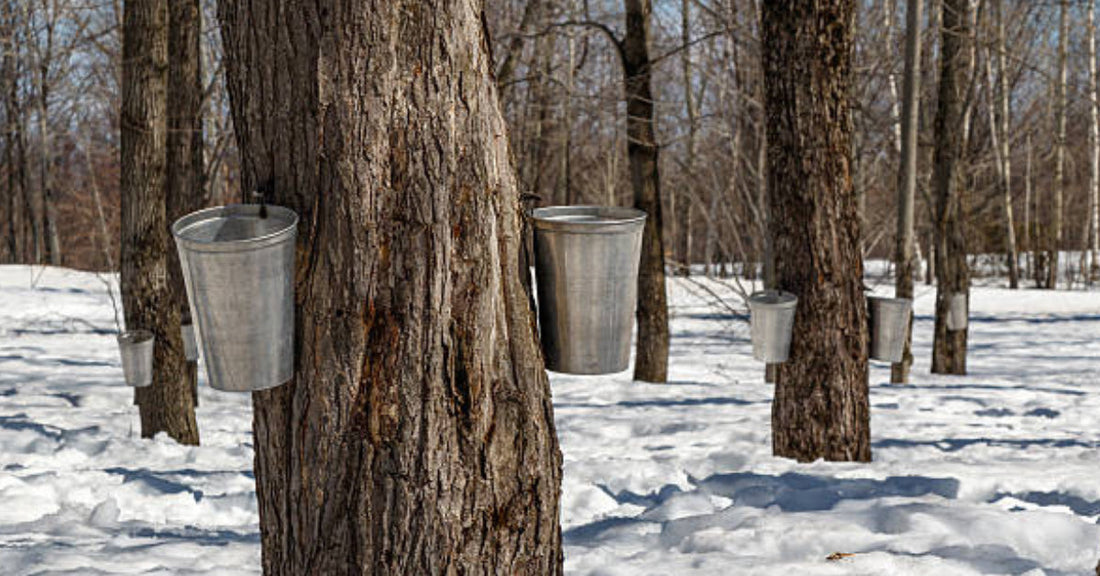Sugaring-off is the first outdoor agricultural activity of the year that signals the arrival of spring. It always evokes happy memories, such as strolling through the maple grove, drinking from the maple water pails, life in the sugar shack, making maple syrup and the ultimate, taffy on the snow to sweeten the taste buds.
It's during summer that the maple tree creates its precious sugar through photosynthesis. This sugar enables the tree's cells to breathe, promoting growth and accumulating in its roots as a starch reserve.5
Maple water: first and foremost, the sugar maple tree
The sugar maple is a member of the Aceraceae family. Its habitat extends all along the Appalachian chain, from the south of the St. Lawrence River to Maine in the United States. It thrives in moist, cool but sunny, well-drained forests. It enjoys the company of species such as ash, hickory, basswood and ostrich.
Sugar maples can grow up to 35 m tall and live up to 200 years. Its wood is hard, heavy and pale yellow in color. There are over 150 species of maple worldwide. However, only the sugar and red maples provide us with the maple sap, or maple water, essential for the production of maple syrup.7
A little history...
Aboriginals made their spears and picks from this hard wood. In times of famine, they ground the inner bark to a powder and used it as flour. Long before the arrival of the first settlers, they discovered the nutritional value of young maple shoots and seeds, and the gustatory qualities of maple water.7
A time of sugars
In spring, the alternating freezing and thawing between night and day causes the maple water to flow. For example, a difference of -8°C at night and +8°C during the day is ideal.
Sap is drawn to the tops of trees when the branches most exposed to the cold freeze. As the temperature rises above freezing (around 5°C), the sap becomes liquid again and gravitates down the tree.
Find out more: Our recipe for spring risotto with maple water
Tree sap circulates for about six to eight weeks from the beginning of March. This sap provides the tree with the energy it needs to grow. Since the spring harvest takes only 5% of its sugar reserves, the tree retains everything it needs to stay healthy.
Quebec supplies 70% of the world's maple syrup - hundreds of millions of liters every year.4
Maple water and its benefits
Maple water is mainly used to produce maple syrup, but there's a new attraction: hydrating with maple water. This water is now carving out an important place for itself on the market, because beyond its unique taste, it has health benefits.
Maple water contains numerous nutrients such as minerals (manganese, calcium, iron, copper), amino acids (for regulating metabolic processes), electrolytes (for hydration), phenolic compounds and flavonoids known for their powerful antioxidant effect.3, 4
In the precious liquid, researchers at Laval University have identified a powerful, anti-inflammatory antioxidant compound they have named 'Québécol'.6
Medicinal properties attributed to maple sap include Alkalizing, anti-inflammatory, febrifuge, laxative, nutritive, prebiotic, purgative, regenerative, tonic, vulnerary.7
Maple water, a hydrating drink
This raw product can be used on its own as a hydrating drink during physical exertion, to maintain a more stable energy level, and aid recovery more quickly than would an energy drink without the effects of caffeine. This water can be drunk as is, or simply used to make a morning coffee or afternoon tea, or for a herbal infusion during the day. It can also be used for cooking foods such as rice, pasta, etc..
Maple water: An innovative product with Maple 3
Maple 3 offers a variety of maple water products, including pure maple water and a new line of sparkling maple waters available in 3 flavors (Original, lime and peach/mango).1
Maple 3 Company
The mission of Maple 3 is to inspire people to hydrate naturally so they can always be at their best.
L'Maple 3 maple water naturally contains 46 bioactives, electrolytes and minerals, and a subtle maple taste, making it an amazing hydration solution. Maple 3 is now available in over 10 countries, from Canada to Korea.1
Maple 3: eco-responsible sourcing
Every spring, maple water is collected directly from Canadian forests. No damage is done to the trees. Harvesting and drinking maple water actually prevents deforestation.1
Maple 3 inaugurated the world's first maple grove dedicated specifically to the production of maple water. biological maple water, harvested from Saint-Ferdinand's mature maple trees.
Maple 3 maple water, on the other hand, is available all year round.
From maple to you, a natural hydration solution.
About the author
Marie Couture, Certified Naturopath
Specialized in :
- Digestive disorders
- Inflammation
- Hormonal problems
- Stress management
References :
- https://maple3.ca
- https://fr.wikipedia.org/wiki/%C3%89rable_%C3%A0_sucre
- https://ici.radio-canada.ca/nouvelle/1088471/eau-erable-boisson-vertus-popularite-engouement
- https://www.canalvie.com/sante-beaute/nutrition/infos-et-conseils/les-bienfaits-de-l-erable-1.781751
- https://www.lafermemartinette.com/le-phenomene-de-la-coulee-de-seve/
- https://ici.radio-canada.ca/nouvelle/625519/sirop-erable-laboratoire-quebecol
- Schneider Anny, Native medicinal plantsLes Éditions de l'homme, 2020, 265 pages



